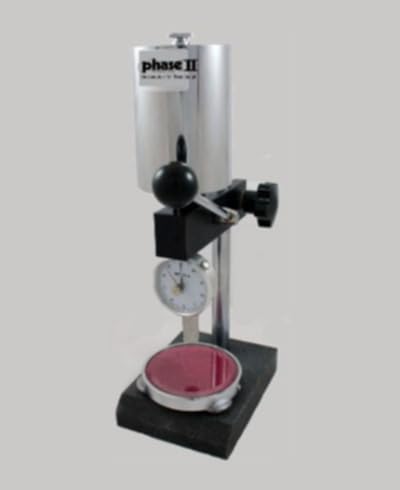
Product Information
Specification
Brand : Accusize Industrial Tools
BulletPoint1 : This Phase II Shore D durometer test stands is used to improve the accuracy and reproducibility of both analog and digital durometer hardness tester readings by ensuring that the presser foot is exactly parallel to the specimen table.
BulletPoint2 : Durometer measurement scales range from 0 to 100 but there is no such thing as a durometer unit of measurement. Another way of saying this is that durometer is a dimensionless measurement.
BulletPoint3 : Durometer numbers simply represent a relative comparison of hardness between different but similar materials that have had their hardness measured using the same durometer scale, device and measurement standard.
BulletPoint4 : Higher numbers on the scale indicate a greater resistance to indentation and thus harder materials.
BulletPoint5 : Lower numbers indicate less resistance and softer materials.
ExternallyAssignedProductIdentifier1 : 0663566035307
ExternallyAssignedProductIdentifier2 : 663566035307
FinishType : Finish
IncludedComponents : inc
ItemName : Accusize Industrial Tools PhaseII+ Support Stand for PHT-980, PHT-981
ItemPackageDimensions_Height : 2 centimeters
ItemPackageDimensions_Length : 8 centimeters
ItemPackageDimensions_Width : 5 centimeters
ItemPackageQuantity : 1
ItemTypeKeyword : hardness-testing-apparatus
Manufacturer : Phase II Plus
Material : Material
ModelNumber : Fafeicyg1k7gwdi3t
NumberOfItems : 1
PartNumber : PHT-981
PowerSourceType : PowerSource
ProductDescription :
Shore D Durometer Stand
Model No. PHT-981
This Phase II Shore D durometer test stands is used to improve the accuracy and reproducibility of both analog and digital durometer hardness tester readings by ensuring that the presser foot is exactly parallel to the specimen table.
Durometer or Shore durometer is a standardized way to measure the hardness of materials like rubber (elastomers) and plastics. Durometer measurement scales range from 0 to 100 but there is no such thing as a durometer unit of measurement. Another way of saying this is that durometer is a dimensionless measurement.
Durometer numbers simply represent a relative comparison of hardness between different but similar materials that have had their hardness measured using the same durometer scale, device and measurement standard.
In general, a higher durometer elastomer is harder than a lower durometer elastomer. For example, a 90A durometer polyurethane tubing is harder than a 70A polyurethane tubing.
Higher numbers on the scale indicate a greater resistance to indentation and thus harder materials. Lower numbers indicate less resistance and softer materials.
The term is also used to describe a material’s rating on the scale, as in an object having a “‘Shore durometer’ of 90.”
The Shore scale was defined by Albert Shore, who developed a suitable device to measure hardness in the 1920s. It was neither the first hardness tester nor the first to be called a durometer, but today that name usually refers to Shore hardness; other devices use other measures, which return corresponding results, such as for rockwell hardness.
There are several scales of durometer, used for materials with different properties. The two most common scales, using slightly different measurement systems, are the ASTM D2240 type A and type D scales.
The A scale is for softer ones, while the D scale is for harder ones.
ProductSiteLaunchDate : 2017-07-07T16:09:55.495Z
Style : Modern



